The Intel Comet Lake Core i9-10900K, i7-10700K, i5-10600K CPU Review: Skylake We Go Again
by Dr. Ian Cutress on May 20, 2020 9:00 AM EST- Posted in
- CPUs
- Intel
- Skylake
- 14nm
- Z490
- 10th Gen Core
- Comet Lake
Power
We kind of gave a sneak preview on the front page with our frequency graph, but the short answer as to whether these new Core i9 processors really need 250 W for 10 cores is yes. Intel sent us details on what it has determined should be the recommended settings for its K processor line:
- Core i9-10900K: TDP is 125 W, PL2 is 250 W, Tau is 56 seconds
- Core i7-10700K: TDP is 125 W, PL2 is 229 W, Tau is 56 seconds
- Core i5-10600K: TDP is 125 W, PL2 is 182 W, Tau is 56 seconds
For those not used to these terms, we have the TDP or Thermal Design Power, which is meant to be the long-term sustained power draw of the processor at which Intel guarantees the base frequency of the processor – so in this case, the Core i9-10900K guarantees that with a heavy, long-running workload it will max out at 125 W with a frequency of at least 3.7 GHz (the base frequency).
The PL2 is known as the turbo power limit, which means that while the processor is allowed to turbo, this is the upper power limit that the processor can reach. As mentioned on the first page of this review, the value for PL2 is only a suggested guide, and Intel lets motherboard vendors set this value to whatever they want based on how well the motherboard is designed. Sometimes in laptops we will see this value lower than what Intel recommends for thermal or battery reasons, however on consumer motherboards often this value is as high as it can possibly be.
The final term, Tau, is meant to be a time by which the turbo can happen. In reality the TDP value and the Tau value is multiplied together to give a value for a ‘bucket’ of energy that the processor can use to turbo with. The bucket is refilled at a continuous rate, but if there is excess energy then the processor can turbo – if the bucket is being emptied at the same rate as it is refilled, then the processor is down at the long-term TDP power limit. Again, this is a value that Intel recommends and does not fix for the vendors, and most consumer motherboards have Tau set to 999 seconds (or the equivalent of infinite time) so the processor can turbo as much as possible.
Note, when we asked Intel about why it doesn’t make these hard specifications and how we should test CPUs given that we’re somewhat enable to keep any motherboard consistent (it might change between BIOS revisions) for a pure CPU review, the response was to test a good board and a bad board. I think that on some level Intel’s engineers don’t realize how much Intel’s partners abuse the ability to set PL2 and Tau to whatever values they want.
All that aside, we did some extensive power testing on all three of our CPUs across a number of simulation and real-world benchmarks.
Core i9-10900K Power
Through our tests, we saw the Intel Core i9-10900K peak at 254 W during our AVX2-accelerated y-cruncher test. LINPACK and 3DPMavx did not push the processor as hard.
The more real-world tests, AI Benchmark and Photoscan, showed that in a variable operation workload mixing threads, we are more likely to see the 125-150 W range, with spikes up to 200W for specific operations.
For users interested in the voltage for our Core i9-10900K, we saw the processor peak at 1.34 volts, however even during an AVX2 workload it was nearer to 1.25 volts.
Intel Core i7-10700K
The Intel Core i7-10700K is rated by Intel to have a peak turbo power of 229 W, however our sample peaked at 207 W during y-Cruncher. LINPACK achieved similar results, whereas 3DPMavx was nearer 160 W.
Our AI Benchmark power wrapper failed for the 10700K due to a configuration issue, but the Photoscan ‘real world’ power test put the processor mostly in the 100-125 W range, peaking just below 150 W in a couple of places.
Intel Core i5-10600K
Intel’s Core i5-10600K has a recommended PL2 of 182 W, but we observed a peak of 125 W in y-Cruncher and 131 W in LINPACK.
We actually saw our AI Benchmark real-world test hit 130 W as well, while Photoscan was nearer the 60-80 W range for most of the test.
The full set of power graphs can be found here:
In terms of overall peak power consumption, our values look like this:
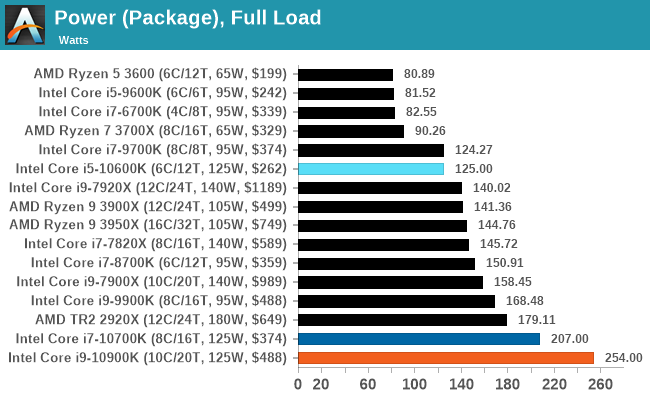
Note, 254 W is quite a lot, and we get 10 cores at 4.9 GHz out of it. By comparison, AMD's 3990X gives 64 cores at 3.2 GHz for 280 W, which goes to show the trade-offs between going wide and going deep. Which one would you rather have?



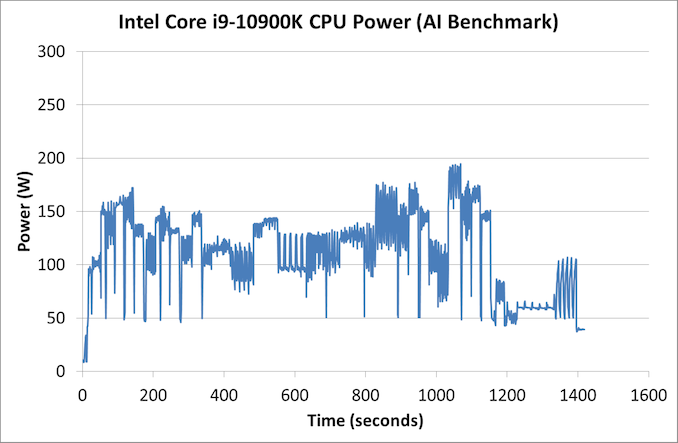
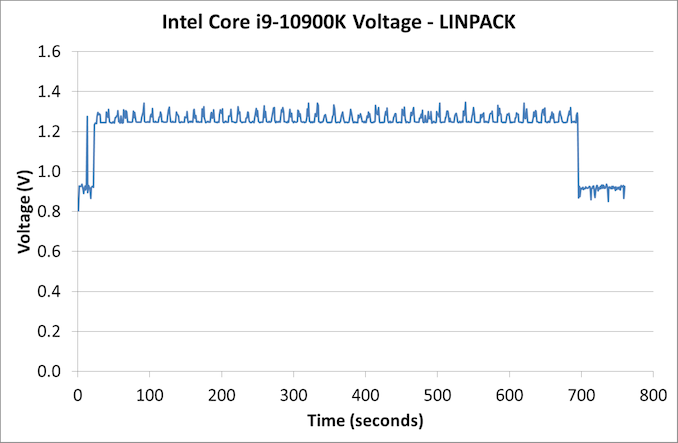
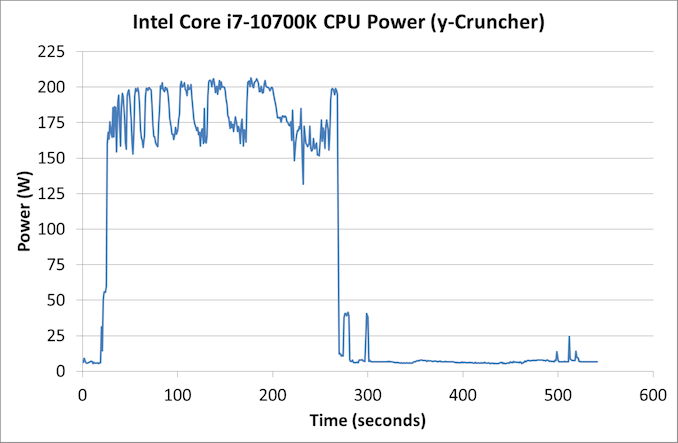
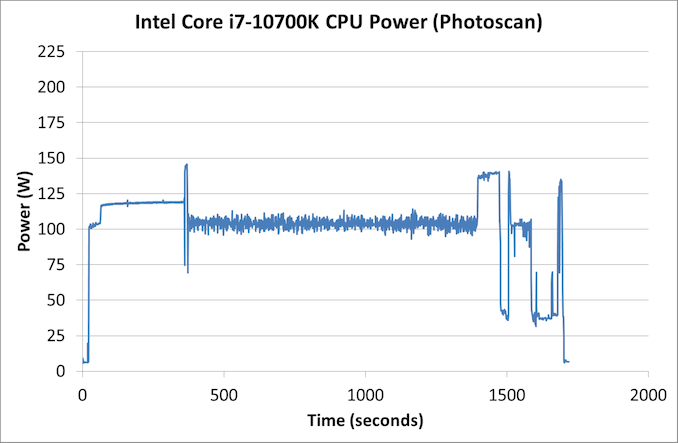
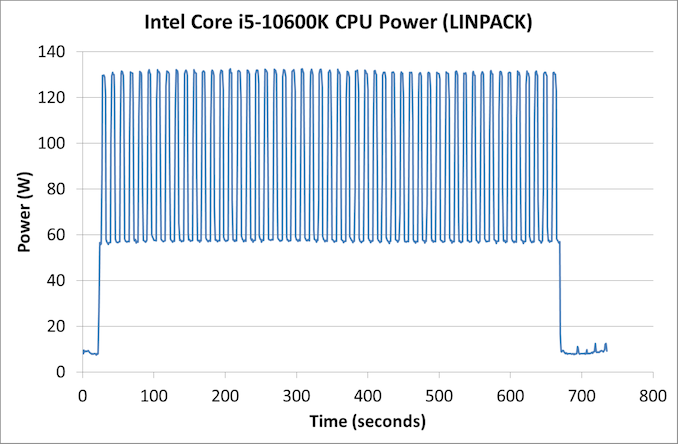
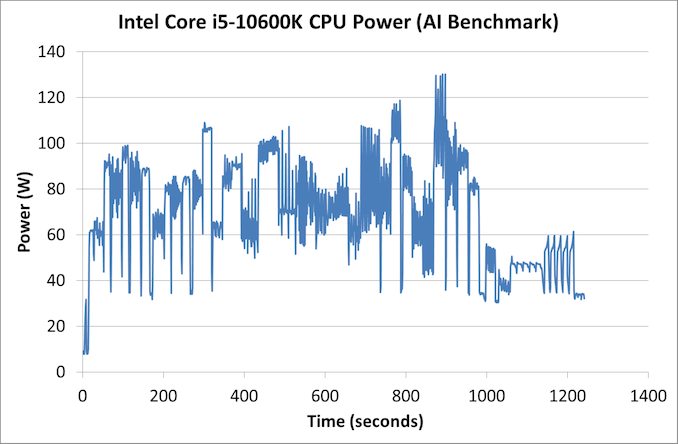














220 Comments
View All Comments
Gastec - Friday, May 22, 2020 - link
Basically you just have to type "allyourbasearebelongtous +$50/surprisemechanic" and you get all the framerate you want in your favorite multiplayer FPShooter.Boshum - Wednesday, May 20, 2020 - link
I think it's a viable alternative to Ryzen 3000, so it's not pointless. It's about equal in performance for most people. A little more expensive and power hungry core for core, but it's more of a flavor thing now. It's still better for certain gaming and application scenarios. Hyperthreading makes the low to midrange a much more reasonable option too, with heat and power being no big deal there. The only place it can't compete with Ryzen is at the very high end for power users doing heavy multi-core work.Dribble - Wednesday, May 20, 2020 - link
I'd be the sort of person to look at a 10700K but power usage is just too high. I want to be able to stick a high end air cooler on it, o/c and still have it run pretty quiet. I'd have to go water with one of these and I can't be bothered with that. Not worth it for the small performance increment over more efficient chips.IBM760XL - Wednesday, May 20, 2020 - link
Agreed. The 10700K and 10900K use more power per core than my ancient-but-trusty 2500K, at least with stock settings. Sure, the new chips get somewhat better IPC, but I can't justify switching from a Sandy Bridge that's nice and quiet even at 100% load, to a Comet Lake that will require Serious Cooling to have an outside chance of being as quiet.I could look at lower-end hex-core Comet Lake chips instead, but why would I do that when I could just as well get an octo-core Ryzen 7 3700, or a Ryzen 5 3600 that will have better performance than an i5-10500?
Boshum - Wednesday, May 20, 2020 - link
I should think the 10500 and 3600 would be pretty close at stock, though you have more overclocking options with the 3600. It's the future Rocket Lake vs Ryzen 4000 options that is more interesting.warrenk81 - Wednesday, May 20, 2020 - link
typo in the dropdown for the final page, move/more.colonelclaw - Wednesday, May 20, 2020 - link
Grammar error, too. Less/fewer.Flunk - Wednesday, May 20, 2020 - link
Well, Intel's back on top for gaming, by a small marging, with chips that can fry an egg. Maybe it'll force AMD to lower their prices on their high-end chips. I don't really fancy a 250+ Watt CPU.DrKlahn - Wednesday, May 20, 2020 - link
You can already get the 3900x for $410 on Amazon. Unless you have a use case that heavily favors Intel that would seem to be a pretty good value already. A good B450 board capable of handling it could be had for not much more than the difference in chip cost (provided that fits your needs).Irata - Wednesday, May 20, 2020 - link
Yup, and like the article says that includes an HSF that will do the job.Contrast that with the 10900k which retails for $530 on Newegg (not available) and which requires you to spend $ 200+ for a proper cooling set up and you are looking at $ 410 vs. $ 730, i.e. paying 56% more for the 10900k. And that does not even include case fans, mainboard, PSU.
If gaming is what one is after, the 9700k looks much more attractive than the 10900k.